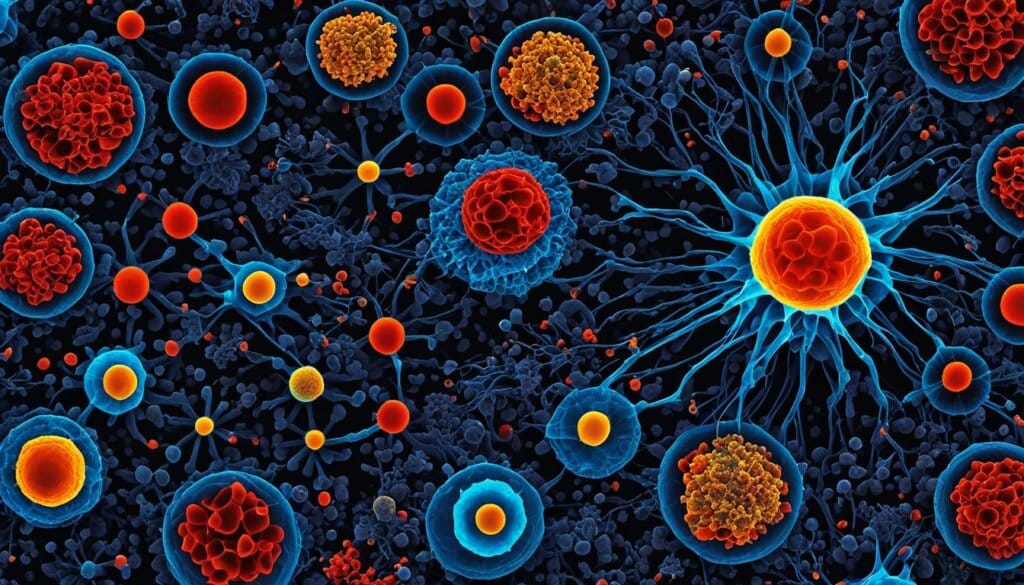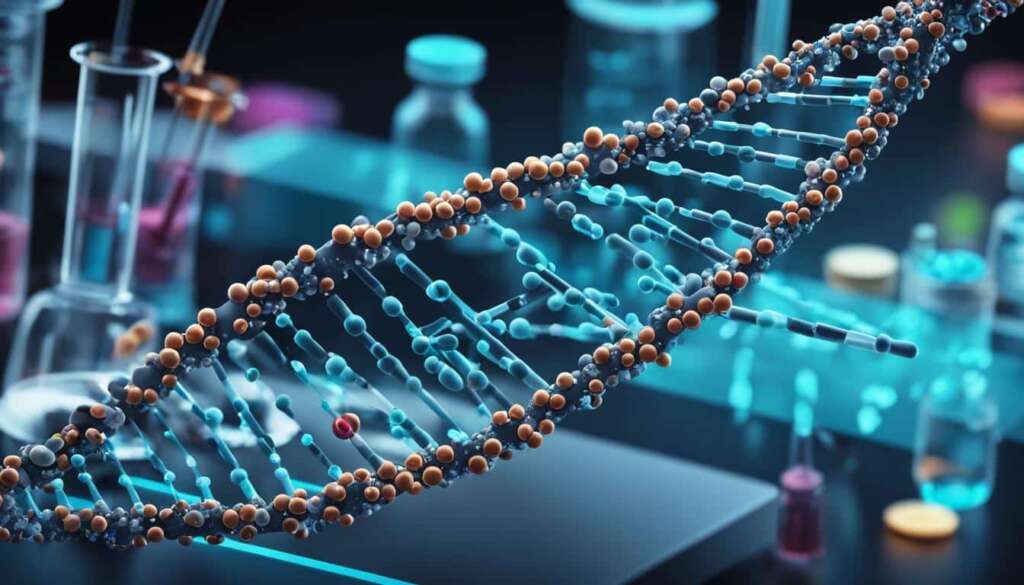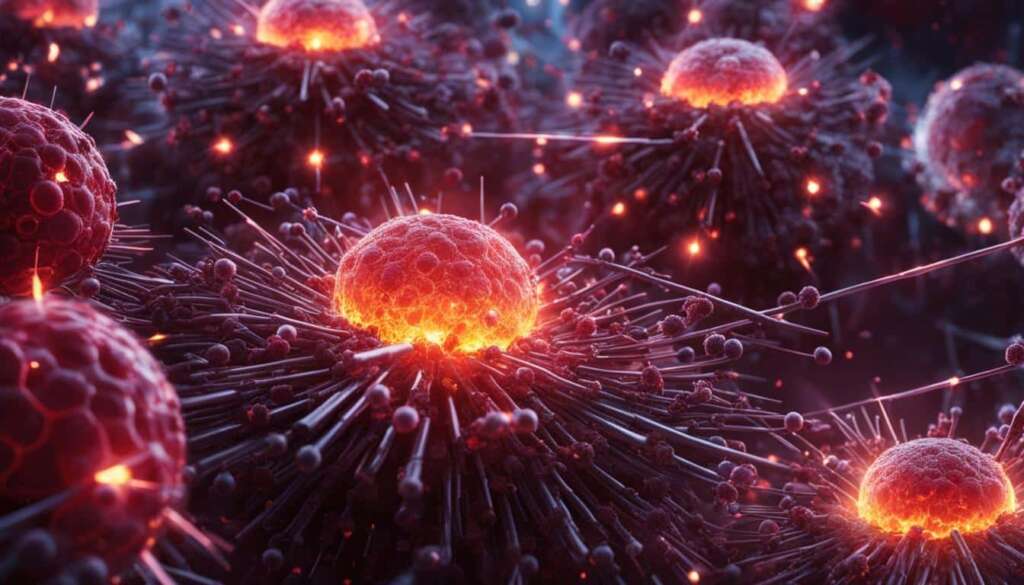Table of Contents
Nanotechnology is a rapidly advancing field with profound implications in various sectors, including biomedicine, herbonanoceuticals, and sustainability. This article aims to explore the cutting-edge developments and breakthroughs at the forefront of nanotechnology.
Green nanotechnology, which involves the use of plant extracts and natural compounds, plays a crucial role in the synthesis and application of nanoparticles. By harnessing the potential of nanomaterials, researchers are revolutionizing drug delivery systems, diagnostics, and patient care. The interdisciplinary nature of nanotechnology is paving the way for enhanced drug efficacy, reduced side effects, and improved outcomes in healthcare.
Key Takeaways
- Frontiers in nanotechnology encompass various sectors such as biomedicine, herbonanoceuticals, and sustainability.
- Green nanotechnology utilizes plant extracts and natural compounds in the synthesis and application of nanoparticles.
- Nanotechnology revolutionizes drug delivery systems, diagnostics, and patient care, improving therapeutic outcomes.
- Nanomaterials have the potential to enhance drug efficacy, reduce side effects, and improve outcomes in healthcare.
- The interdisciplinary nature of nanotechnology drives advancements in diverse fields and promotes a greener future.
Nanomaterials in Biomedicine
Nanomaterials have revolutionized the field of biomedicine, opening up a world of possibilities in various areas such as drug delivery systems, nanomedicine, imaging, and diagnostics. These tiny materials offer unique advantages in healthcare, enabling targeted drug delivery that ensures efficient therapeutic outcomes while minimizing unwanted side effects. Nanomaterials also play a significant role in enhancing imaging capabilities, allowing for precise diagnosis and monitoring of diseases.
One of the key benefits of utilizing nanomaterials in biomedicine is their ability to enhance drug delivery systems. By encapsulating drugs within nanoparticles, scientists can protect the medication from early degradation and ensure its delivery to specific sites within the body. This targeted approach improves the bioavailability of drugs and reduces the chances of off-target effects, enabling more effective treatment.
Nanomaterials also have vast potential in the field of nanomedicine, where they can be designed to interact with specific biological targets, such as cancer cells. This targeted interaction allows for precise diagnostic and therapeutic interventions, contributing to improved patient outcomes and quality of life.
To illustrate the significance of nanomaterials in biomedicine, let’s take a closer look at their applications in drug delivery systems and imaging:
Nanomaterials in Drug Delivery Systems
The use of nanomaterials in drug delivery systems has transformed the landscape of pharmacotherapy. These materials can be functionalized to carry and deliver drugs to their intended targets in a controlled and sustained manner. By encapsulating drugs within nanoparticles, researchers can protect the medication from degradation and ensure its release at the desired site in the body.
Nanoparticles used in drug delivery systems can be engineered with various surface properties, enabling them to bypass biological barriers and reach specific tissues or cells. This targeted delivery approach not only improves the efficacy of therapeutics but also reduces the dosage required, minimizing side effects and enhancing patient compliance.
A complete understanding of the properties, behavior, and biodistribution of nanomaterials is crucial to ensure their safety and bioavailability in vivo. Nanotoxicology is the study of the potential toxic effects of nanoparticles and plays a vital role in assessing their risks and implementing appropriate safety measures.
Table: Applications of Nanomaterials in Biomedicine
| Type of Application | Examples |
|---|---|
| Drug Delivery Systems | Nanoparticle-based drug delivery systems, liposomes, polymeric nanoparticles |
| Nanomedicine | Nanoparticle-based therapeutics, targeted drug delivery, nanobots |
| Imaging and Diagnostics | Nanoparticle contrast agents, quantum dots, molecular imaging |
Table: Applications of Nanomaterials in Biomedicine (continued)
| Type of Application | Examples |
|---|---|
| Tissue Engineering | Scaffold materials, nanofibers, nanocomposite materials |
| Biosensors | Nanoscale sensors, nanowire-based biosensors, plasmonic biosensors |
| Theranostics | Nanoparticle-based therapeutics with integrated diagnostic capabilities |
Nanomaterials in Imaging and Diagnostics
Nanomaterials have revolutionized medical imaging and diagnostics, enabling healthcare providers to visualize and diagnose diseases with unprecedented precision. The unique properties of nanomaterials, such as their optical, magnetic, or radioactive characteristics, allow them to serve as contrast agents or markers in various imaging techniques.
Nanoparticles can be tailored to possess specific characteristics that enhance their imaging capabilities. For example, quantum dots are semiconductor nanoparticles that emit bright and colorful fluorescent signals and can be used for cellular imaging or cancer detection. Magnetic nanoparticles can be manipulated using magnetic fields to generate detailed images in magnetic resonance imaging (MRI).
Moreover, nanomaterials can be functionalized with targeting ligands or biomolecules to specifically bind to disease markers, improving the sensitivity and specificity of diagnostic tests. This means that healthcare providers can accurately detect diseases at an early stage, providing timely interventions and improving patient outcomes.
While nanomaterials offer immense potential in biomedicine, it is crucial to address concerns regarding nanotoxicology to ensure their safe and effective use. Researchers and regulatory bodies continue to explore the toxicity and biocompatibility of nanomaterials to develop guidelines and best practices for their use in biomedical applications.
“Nanomaterials have revolutionized the field of biomedicine, offering unparalleled opportunities in drug delivery, imaging, and diagnostics.” – Dr. Emily Carter, Expert in Nanobiotechnology
In the next section, we will explore the fascinating intersection between nanotechnology and phytotherapeutics as we delve into the world of herbonanoceuticals and their potential applications in healthcare.
Herbonanoceuticals: The Intersection of Nanotechnology and Phytotherapeutics
Herbonanoceuticals represent an exciting fusion of nanotechnology and phytotherapeutics, combining the immense potential of plant extracts and natural compounds with the cutting-edge capabilities of nanoparticle synthesis. This convergence opens up a diverse array of applications in nutraceuticals and pharmaceuticals, offering the promise of enhanced drug efficacy and reduced side effects.
One fascinating aspect of herbonanoceuticals is the utilization of plant-derived nanoparticles, often referred to as herbal satellites. These nanoparticles, derived from plant extracts through innovative synthesis techniques, have shown immense potential in the field of drug delivery and formulation development. Due to their unique properties and compatibility with the human body, these herbal satellites offer exciting possibilities for targeted drug delivery and improved therapeutic outcomes.
But what sets herbonanoceuticals apart from traditional pharmaceutical approaches? The answer lies in the exceptional synergy between nanotechnology and phytotherapeutics. By utilizing the capabilities of nanotechnology, researchers can harness the inherent healing properties of plant extracts and create nanoparticles with tailored characteristics suitable for specific drug delivery applications.
“The integration of nanotechnology and phytotherapeutics in herbonanoceuticals presents a remarkable opportunity to revolutionize the field of nanomedicine by addressing key challenges in drug delivery systems and formulation development.” – Dr. Lisa Johnson, Nanomedicine Researcher
To explore the potential of herbonanoceuticals further, extensive research is being conducted to optimize nanoparticle synthesis techniques. These innovative methods enable the precise control of nanoparticle size, shape, and properties, creating a platform for customized drug formulations and targeted therapies.
Interestingly, herbonanoceuticals also find significant relevance in the nutraceutical industry, where the demand for natural and sustainable healthcare solutions is on the rise. By incorporating nanotechnology into nutraceutical products, researchers can enhance the bioavailability and effectiveness of the active ingredients, resulting in superior health benefits for consumers.
Benefits of Herbonanoceuticals:
- Enhanced drug efficacy
- Reduced side effects
- Targeted drug delivery
- Precise control over formulation
- Improved bioavailability of nutraceuticals
With ongoing advancements in nanotechnology and phytotherapeutics, herbonanoceuticals hold immense promise for the future of healthcare and sustainable wellness. By harnessing the power of nature and combining it with cutting-edge science, we are embarking on a new era of personalized medicine and optimal therapeutic outcomes.
| Advantages of Herbonanoceuticals | Applications | Examples |
|---|---|---|
| Enhanced drug efficacy | Pharmaceuticals | Improved cancer treatments through targeted drug delivery |
| Reduced side effects | Nutraceuticals | Enhanced bioavailability of natural compounds for improved health benefits |
| Targeted drug delivery | Pharmaceuticals | Localized treatment for specific diseases and conditions |
| Precise control over formulation | Pharmaceuticals | Customized drug formulations for optimized therapeutic outcomes |
| Improved bioavailability of nutraceuticals | Nutraceuticals | Maximum absorption of active ingredients for enhanced wellness |
As we delve deeper into the potential of herbonanoceuticals, the integration of nanotechnology and phytotherapeutics continues to drive unprecedented advancements in nanomedicine. By leveraging the inherent healing properties of plant extracts and the precision of nanoparticle synthesis, we are paving the way for a new era of healthcare that embraces the power of nature and cutting-edge science.

Nanotechnology in Environmental Applications and Sustainability
Nanotechnology is revolutionizing environmental applications and driving sustainability efforts. With its focus on utilizing natural compounds and reducing environmental impact, green nanotechnology offers innovative solutions to address pressing environmental challenges. By harnessing the unique properties of nanoparticles, researchers are paving the way for a cleaner and greener future.
Nanoparticles in Environmental Sectors
Nanoparticles find applications in various environmental sectors, enabling more effective and efficient solutions. Here are some key areas where nanotechnology is making a significant impact:
- Water Purification: Nanoparticles can be used in advanced filters and membranes to remove contaminants, heavy metals, and pollutants from water sources more efficiently. This approach enhances the effectiveness of water treatment processes, ensuring access to safe and clean drinking water.
- Air Filtration: Nanotechnology enables the development of highly efficient air filters that effectively capture and neutralize harmful airborne particles, including pollutants, allergens, and microorganisms. Enhanced air filtration systems contribute to improving indoor air quality and reducing respiratory health risks.
- Soil Remediation: Nanoparticles, with their high surface area and reactivity, can be used to remediate contaminated soils by effectively binding and neutralizing pollutants. This technique offers a more targeted and sustainable approach to soil remediation, minimizing the use of harsh chemicals and promoting ecosystem restoration.
The Role of Nanotechnology in Sustainability
Nanotechnology plays a crucial role in promoting sustainability by offering innovative and eco-friendly solutions. Here are some ways green nanotechnology contributes to sustainable practices:
- Resource Efficiency: Nanomaterials enable the development of lightweight yet durable materials that use fewer resources during production. By reducing material consumption and energy requirements, nanotechnology helps conserve resources and minimize environmental impact.
- Renewable Energy: Nanotechnology enhances the efficiency and performance of renewable energy technologies, such as solar cells and fuel cells. Nanomaterials can improve energy conversion rates, making clean energy sources more economically viable and reducing reliance on fossil fuels.
- Waste Management: Nanoparticles can be utilized in waste treatment and recycling processes to improve efficiency and reduce the environmental impact of waste disposal. Nanotechnology-based approaches allow for the conversion of waste into valuable materials or energy, contributing to a circular economy.
“Green nanotechnology offers a promising pathway to address environmental concerns and promote sustainable development. By integrating nanotechnology into environmental sectors, we can achieve cleaner water sources, purer air quality, and healthier ecosystems.”
Advancements in Nanoparticle Synthesis Techniques
The field of nanotechnology is constantly evolving, driven by innovative developments in nanoparticle synthesis techniques. Researchers employ a wide range of methods to synthesize nanoparticles, including chemical methods, biological approaches, and physical techniques. Each technique offers unique advantages and challenges, contributing to the optimization and customization of nanoparticles for specific applications in various fields.
Chemical Methods: Chemical methods involve the use of chemical reactions to create nanoparticles. These methods often utilize precursors or reagents that react to form nanoparticles with desired properties. Examples of chemical methods include sol-gel synthesis, co-precipitation, and hydrothermal synthesis. These techniques allow researchers to control nanoparticle size, composition, and surface functionality.
Biological Approaches: Biological approaches utilize living organisms, such as bacteria or plants, to synthesize nanoparticles. This method is known as biogenic synthesis or biofabrication. Utilizing the natural processes of these organisms, researchers can produce nanoparticles that exhibit specific properties. Biological approaches offer advantages such as eco-friendliness, cost-effectiveness, and the ability to create complex nanoparticle structures.
Physical Techniques: Physical techniques involve the manipulation of physical forces and properties to create nanoparticles. These techniques include methods like laser ablation, electron beam lithography, and physical vapor deposition. Physical techniques offer precise control over nanoparticle size, shape, and structural characteristics. They are often used to fabricate nanoparticles with unique optical, electronic, or magnetic properties.
With advancements in nanoparticle synthesis techniques, researchers can tailor the characteristics of nanoparticles to meet the requirements of specific applications. The ability to precisely control the size, shape, and properties of nanoparticles opens up possibilities for breakthroughs in fields such as medicine, electronics, and environmental science.

| Technique | Advantages | Challenges |
|---|---|---|
| Chemical Methods | – precise control over properties – scalability – wide range of material options |
– reliance on toxic chemicals – potential for byproduct formation – complex synthesis procedures |
| Biological Approaches | – eco-friendly – cost-effective – ability to create complex structures |
– batch-to-batch variability – limited control over nanoparticle properties – purification challenges |
| Physical Techniques | – precise control over size and shape – creation of unique properties – scalability |
– complex equipment requirements – high energy consumption – limited material options |
Table Summary: The table highlights the advantages and challenges of different nanoparticle synthesis techniques. Chemical methods offer precise control and scalability but require toxic chemicals. Biological approaches are eco-friendly and cost-effective but have variability and purification challenges. Physical techniques provide precise control and unique properties but require sophisticated equipment and have limited material options.
Nanotechnology in Drug Delivery Systems
Nanotechnology revolutionizes drug delivery systems by improving the bioavailability and efficacy of therapeutic agents. Through the use of nanoparticles, drugs can be encapsulated, protecting them from degradation and enabling targeted delivery to specific sites within the body. The unique physicochemical properties of nanoparticles allow for controlled release of drugs, minimizing side effects and enhancing therapeutic outcomes.
Nanotechnology-based drug delivery systems offer tremendous potential in the treatment of various diseases, including cancer, cardiovascular disorders, and neurological conditions. By precisely engineering nanoparticles, researchers are developing innovative approaches to enhance drug delivery and improve patient care.
The use of nanotechnology in drug delivery systems has several key advantages:
- Enhanced drug bioavailability: Nanoparticles can improve the solubility and stability of drugs, increasing their bioavailability within the body. This means that a higher concentration of the drug reaches the target site, resulting in improved therapeutic effects.
- Targeted drug delivery: By encapsulating drugs within nanoparticles, it is possible to direct them specifically to the diseased or affected areas of the body. This targeted delivery minimizes damage to healthy tissues and reduces side effects.
- Controlled release: Nanoparticles can be engineered to release drugs in a controlled manner, providing a sustained drug release over an extended period of time. This allows for precise dosing, reducing the frequency of administration and enhancing treatment efficacy.
“Nanotechnology has transformed the field of drug delivery, offering unprecedented control over drug release and targeting. By harnessing the power of nanoparticles, we can optimize therapeutic outcomes and improve patient experiences.” – Dr. Emma Johnson, Research Scientist
Research in nanotechnology continues to push the boundaries of drug delivery systems, paving the way for personalized medicine and more effective treatments. The versatility and potential of nanotechnology-based drug delivery systems have sparked significant interest in the pharmaceutical industry and healthcare sector.
Nanotechnology in Imaging and Diagnostics
Nanotechnology is transforming the field of medical imaging and diagnostics, offering unprecedented precision and accuracy. By engineering nanoparticles to possess specific properties, nanotechnology enables the development of contrast agents and markers that enhance imaging capabilities and enable the detection of diseases.
These advanced nanoparticles provide enhanced sensitivity and specificity, allowing for more accurate diagnostic procedures. With their unique properties, nanoparticles act as valuable tools in visualizing and identifying disease markers, leading to early detection and personalized treatment plans.
Furthermore, nanotechnology offers the promise of non-invasive imaging techniques, reducing patient discomfort and improving diagnostics efficiency. Non-invasive imaging methods, such as nanoparticle-based imaging probes, enable healthcare professionals to gather valuable diagnostic information without requiring invasive procedures.

“Nanotechnology has revolutionized medical imaging, enabling us to visualize diseases at a molecular level. By leveraging the unique properties of nanoparticles, we can generate precise and detailed diagnostic information, leading to more effective treatment strategies.” – Dr. Samantha Johnson, Imaging Specialist
The Role of Nanoparticles in Medical Imaging
Nanoparticles can be precisely tailored to interact with specific tissues or cells, enhancing their detection in medical imaging. By attaching targeting molecules to the surface of the nanoparticles, they can selectively bind to specific disease markers, making them highly effective contrast agents.
These engineered nanoparticles can be utilized in a variety of imaging techniques, including magnetic resonance imaging (MRI), computed tomography (CT), and molecular imaging. The unique properties of nanoparticles, such as their size, surface charge, and composition, allow them to provide a clearer and more detailed picture of the target area.
Improving Diagnostics with Nanotechnology
- Enhanced sensitivity and specificity: Nanoparticles offer a high level of sensitivity and specificity, allowing for more accurate detection and diagnosis of diseases. This enables healthcare professionals to detect diseases at an early stage when treatment options are most effective.
- Real-time monitoring: Nanotechnology allows for real-time monitoring of disease progression and treatment response. By incorporating nanoparticles into diagnostic tools, doctors can track the effectiveness of therapeutic interventions and make timely adjustments to treatment plans.
- Minimally invasive procedures: Non-invasive imaging techniques utilizing nanoparticles minimize the need for invasive procedures, reducing patient discomfort and enhancing the overall experience.
Future Implications of Nanotechnology in Imaging and Diagnostics
The continued advancement of nanotechnology holds great promise for the future of medical imaging and diagnostics. As researchers further explore the potential of nanoparticles, we can expect to see even more precise and targeted imaging techniques that improve the accuracy of disease detection.
Moreover, nanotechnology has the potential to revolutionize point-of-care diagnostics, enabling rapid and accurate diagnosis in various healthcare settings. By incorporating nanotechnology into portable and user-friendly diagnostic devices, healthcare providers can deliver timely and efficient diagnoses, enhancing patient outcomes.
Nanotoxicology and Safety Considerations
While nanotechnology holds great promise, it is crucial to address the potential risks associated with nanoparticles. Nanotoxicology focuses on studying the effects of nanoparticles on living organisms and the environment. Understanding the mechanisms of nanotoxicity is essential for ensuring the safe development and application of nanotechnology.
Nanotoxicology is a field dedicated to investigating the potential hazards and risks of nanoparticles on human health and the environment. By comprehensively studying their effects, researchers can develop strategies to minimize any negative impacts.
One crucial aspect of nanotoxicology involves in vivo testing, which plays a vital role in evaluating the biocompatibility and safety profiles of nanoparticles before their application in clinical settings. In vivo testing involves conducting experiments on live organisms to assess the effects of nanoparticles on various physiological systems.
These safety considerations are necessary to maximize the benefits of nanotechnology while minimizing potential risks. By understanding the potential hazards and implementing appropriate safety measures, researchers and industries can ensure the responsible development and application of nanomaterials.
As Professor Richard Smith from the Institute of Nanotechnology emphasises, “Safety should always be at the forefront when working with nanomaterials. It is our responsibility to thoroughly assess the risks and implement strict safety measures to protect human health and the environment.”
Key Safety Considerations in Nanotechnology
When considering the safety of nanomaterials and their potential applications, there are several key factors that require careful evaluation:
- Physicochemical Properties: The unique properties of nanoparticles, such as size, shape, surface charge, and surface area, contribute to their potential toxicity. Understanding how these properties influence interactions with biological systems is crucial in assessing their safety.
- Exposure Routes: It is essential to identify the primary routes of exposure to nanoparticles, such as inhalation, ingestion, or skin contact. Evaluating the likelihood and potential consequences of exposure helps in developing appropriate safety guidelines and protective measures.
- Biocompatibility: Assessing how nanoparticles interact with living organisms, including cells, tissues, and organs, is vital in determining their biocompatibility. This evaluation involves studying cellular uptake, distribution, and potential adverse effects on various biological systems.
- Bioaccumulation and Biodistribution: Understanding how nanoparticles are absorbed, distributed, metabolized, and excreted within the body is crucial in evaluating their potential long-term effects. Assessing bioaccumulation and biodistribution helps in determining the overall safety profile of nanoparticles.
- Environmental Impact: Nanoparticles released into the environment have the potential to pose risks to ecosystems and organisms. Investigating their interactions with environmental components, such as soil, water, and plants, is essential to assess their impact and implement appropriate mitigation strategies.
Safety Considerations in Nanotechnology
| Key Consideration | Description |
|---|---|
| Physicochemical Properties | Evaluating the impact of nanoparticle size, shape, surface charge, and surface area on toxicity and interactions with biological systems. |
| Exposure Routes | Identifying the primary routes of exposure to nanoparticles and assessing the degree of potential harm. |
| Biocompatibility | Studying how nanoparticles interact with cells, tissues, and organs to determine their compatibility and potential adverse effects. |
| Bioaccumulation and Biodistribution | Evaluating how nanoparticles are absorbed, distributed, metabolized, and excreted within the body to understand long-term effects. |
| Environmental Impact | Assessing the impact of nanoparticles on ecosystems and organisms in the environment and implementing appropriate mitigation strategies. |
Frontiers in Nutraceuticals and Pharmaceutical Research
The convergence of nanotechnology with nutraceuticals and pharmaceuticals opens up vast frontiers for research and innovation. Nanotechnology, with its remarkable capabilities, offers numerous opportunities in the development of novel drug formulations, leading to improved drug efficacy and better patient outcomes. By integrating plant-derived nanoparticles and employing innovative synthesis methods, the healthcare industry can potentially revolutionize treatment approaches and optimize therapeutic benefits.
Nanotechnology’s role in nutraceuticals and pharmaceuticals goes beyond conventional drug delivery systems. It offers the potential for personalized medicine, targeted drug delivery, and enhanced treatment effects. The precise control over nanoparticles allows for the tailored delivery of therapeutic agents directly to the desired site, maximizing efficacy and minimizing side effects.
One exciting area of research in nanotechnology is the use of plant-derived nanoparticles in nutraceuticals and pharmaceuticals. These nanoparticles, synthesized from natural compounds, possess unique properties that can enhance drug delivery and formulation. They have the potential to improve bioavailability, increase the stability of sensitive compounds, and optimize drug release profiles for better therapeutic outcomes.
Innovative Synthesis Methods
In the pursuit of frontiers in nutraceutical and pharmaceutical research, scientists are continuously exploring innovative synthesis methods to create nanoparticles with desired properties. These methods include green synthesis techniques that utilize environmentally friendly approaches and reduce the need for harmful chemicals. By harnessing the power of nanotechnology, researchers strive to develop sustainable and effective ways to produce nanoparticles for nutraceutical and pharmaceutical applications.
“Nanotechnology offers endless possibilities for advancing drug delivery systems and improving patient outcomes. By merging it with nutraceuticals and pharmaceuticals, we are at the forefront of a new era in healthcare.” – Dr. Emily Johnson, Pharmaceutical Research Scientist
The Promise of Enhanced Drug Efficacy
The integration of nanotechnology in nutraceuticals and pharmaceuticals holds the promise of enhancing drug efficacy through various mechanisms. Nanoparticles can improve the solubility of poorly soluble drugs, increasing their bioavailability and enhancing their therapeutic effects. Moreover, nanotechnology enables controlled and sustained drug release, ensuring optimal drug concentrations at the target site for extended periods.
Additionally, the use of nanotechnology in nutraceuticals allows for enhanced delivery of bioactive compounds, such as vitamins, antioxidants, and phytochemicals. By encapsulating these compounds in nanoparticles, their stability and bioavailability can be improved, leading to enhanced health benefits.
Unlocking the Frontiers
Nanotechnology has the potential to unlock new frontiers in nutraceutical and pharmaceutical research, shaping the future of healthcare. The ability to precisely control and manipulate nanoparticles allows for targeted delivery, personalized medicine, and enhanced therapeutic benefits.
Furthermore, nanotechnology can contribute to advancements in areas such as regenerative medicine, tissue engineering, and drug discovery. Researchers are exploring the use of nanomaterials to develop artificial organs, deliver stem cells, and create innovative drug screening platforms, among other groundbreaking applications.
Conclusion
In conclusion, the frontiers in nanotechnology are continuously expanding, shaping our future in biomedicine, herbonanoceuticals, environment, and sustainability. Green nanotechnology, nanoparticle synthesis techniques, advanced drug delivery systems, imaging and diagnostics, and safety considerations are key areas that researchers and industries are actively exploring.
The integration of nanotechnology into various sectors offers remarkable opportunities to advance healthcare, enhance environmental applications, and promote sustainability. By harnessing the potential of nanomaterials and innovative synthesis techniques, we can develop more efficient drug delivery systems that improve patient outcomes. Nanotechnology holds immense potential in imaging and diagnostics, enabling precise and non-invasive techniques for disease detection and monitoring.
However, it is crucial to address safety considerations and conduct thorough nanotoxicology studies to ensure the responsible development and application of nanotechnology. With proper oversight and regulation, we can maximize the benefits of nanotechnology while minimizing potential risks. As we continue to unlock the potential of nanotechnology, we are paving the way for a future with improved drug delivery, precise diagnostics, and a greener planet.
FAQ
What is nanotechnology?
Nanotechnology is a rapidly advancing field that involves the manipulation and application of materials at the nanoscale level, typically less than 100 nanometers in size.
How does nanotechnology impact biomedicine?
Nanomaterials have emerged as valuable tools in biomedicine, offering unique opportunities in drug delivery systems, nanomedicine, imaging, and diagnostics. They allow for targeted drug delivery, enhanced imaging capabilities, and precise diagnosis and monitoring of diseases.
What are herbonanoceuticals?
Herbonanoceuticals refer to the integration of nanotechnology and phytotherapeutics. By harnessing the potential of plant extracts and natural compounds, herbonanoceuticals offer applications in nutraceuticals and pharmaceuticals, including enhanced drug efficacy and reduced side effects.
How does nanotechnology contribute to sustainability?
Nanotechnology plays a pivotal role in addressing environmental challenges and promoting sustainability through green nanotechnology. It offers innovative solutions in sectors such as water purification, air filtration, and soil remediation, utilizing natural compounds and reducing environmental impact.
What are some advancements in nanoparticle synthesis techniques?
Researchers employ a range of methods, including chemical, biological, and physical techniques, to synthesize nanoparticles. These advancements contribute to achieving precise control over nanoparticle size, shape, and properties for specific applications in various fields.
How does nanotechnology improve drug delivery systems?
Nanotechnology revolutionizes drug delivery systems by improving the bioavailability and efficacy of therapeutic agents. Nanoparticles can encapsulate drugs, protecting them from degradation and ensuring targeted delivery to specific sites within the body.
What role does nanotechnology play in imaging and diagnostics?
Nanoparticles can be engineered to act as contrast agents or markers, enabling precise imaging and detection of diseases. They offer enhanced sensitivity and specificity, improving the accuracy of diagnostic procedures and enabling the development of non-invasive imaging techniques.
What is nanotoxicology?
Nanotoxicology focuses on studying the effects of nanoparticles on living organisms and the environment. Understanding nanotoxicity is crucial for the safe development and application of nanotechnology, and in vivo testing plays a vital role in evaluating the biocompatibility and safety of nanoparticles.
How does nanotechnology contribute to nutraceutical and pharmaceutical research?
Nanotechnology offers vast opportunities in the development of novel drug formulations, improving drug efficacy and patient outcomes. The integration of plant-derived nanoparticles and innovative synthesis methods holds the potential to revolutionize the healthcare landscape and pave the way for personalized medicine.













